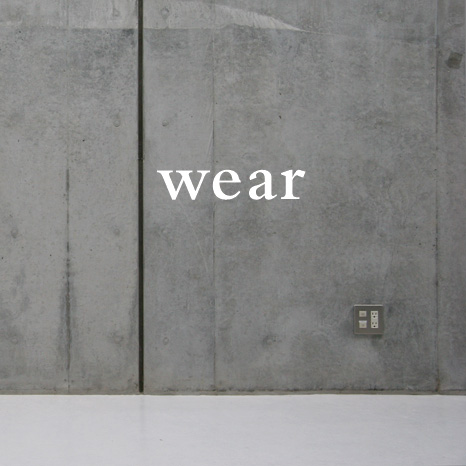The crux of this situation is one of returning to an academic reportage—after the holiday, after the event, after stepping out of the heretofore all-encompassing realm that is the Home and learning to tell or recount (and what not) to our classmates, our teachers, our friends. Spending the entire summer hanging out by the pool and eating sandwiches with the crusts cut off may have been real life. But how much of a real life do we access, relive, or reveal when writing about our experiences, passing them on to others, or trying to capture them via other media simultaneous to the experience (i.e., photographs, audio recording, drawing, etc.)? If we make art from/of our lives are the results still a reflection of the world we live in, and how much do we really reveal about ourselves through the process? More? Less? Is life as recorded in a journal, a newspaper, an uploaded video or a painting symmetrical to “mere life”? Or parallel?
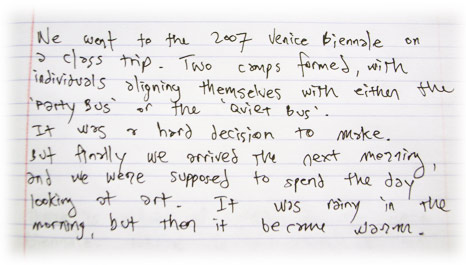 The question of life in art is not at least in part a question of reality and document, of truth and artifact. Insofar that life is being, it is the living element of a work of art, its energeia, which we recognise, or recognises us, is capable of moving us beyond our own mere lives towards truth and Heidegger’s sense of the world worlded, “more fully in being than the tangible and perceptible realm in which we believe ourselves to be at home.” To find, then, the evocation of life in the artwork does not set up a dichotomy as implied by the analogy of reality to document, truth to artifact. We can look perhaps more towards Adorno’s dialectics, not by way of simple polarities but a dialecticalism whereby one is contained in the other—art and life mutually inherent.
The question of life in art is not at least in part a question of reality and document, of truth and artifact. Insofar that life is being, it is the living element of a work of art, its energeia, which we recognise, or recognises us, is capable of moving us beyond our own mere lives towards truth and Heidegger’s sense of the world worlded, “more fully in being than the tangible and perceptible realm in which we believe ourselves to be at home.” To find, then, the evocation of life in the artwork does not set up a dichotomy as implied by the analogy of reality to document, truth to artifact. We can look perhaps more towards Adorno’s dialectics, not by way of simple polarities but a dialecticalism whereby one is contained in the other—art and life mutually inherent.![]() Even so, the “mere life” evoked in a work of art is by no means equal to reality. The distance between the two can be described as a greater truth or a place of the spirit, but perhaps, much less glamourously—not so far off from the gap between seeing someone’s endless vacation slideshow versus having been part of the real experience. One approaches a higher plane of being, the other is, very often, just a bore.
Even so, the “mere life” evoked in a work of art is by no means equal to reality. The distance between the two can be described as a greater truth or a place of the spirit, but perhaps, much less glamourously—not so far off from the gap between seeing someone’s endless vacation slideshow versus having been part of the real experience. One approaches a higher plane of being, the other is, very often, just a bore.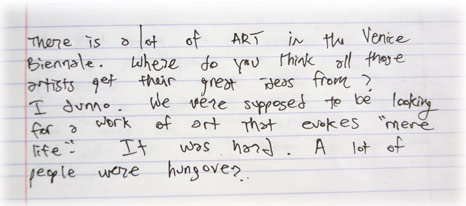 At the Biennale di Venezia, a near Disneyland of contemporary art and national identity, we are afforded the small world after all of contemporary art multiculturalism. The short examples following interest me here as different national perceptions positioning life relative to art. The stereotypes that emerge are perhaps an ironically self-conscious colouring of the ways the simulacra overtakes us even in self-presentation, but at the current stage of hyper visual culture, it is possible in this context to raise new questions regarding art as presentation (show, artifact, material, object) versus documentation (alternate reality, report, medium, subject).
At the Biennale di Venezia, a near Disneyland of contemporary art and national identity, we are afforded the small world after all of contemporary art multiculturalism. The short examples following interest me here as different national perceptions positioning life relative to art. The stereotypes that emerge are perhaps an ironically self-conscious colouring of the ways the simulacra overtakes us even in self-presentation, but at the current stage of hyper visual culture, it is possible in this context to raise new questions regarding art as presentation (show, artifact, material, object) versus documentation (alternate reality, report, medium, subject).![]() Japan, History and Tradition.The most physically direct form of document was created by artist Masao Okabe for the Japan pavilion. His work consisted of a series of 1,400 frottages made with pencil on paper, rubbed directly on the surface of stones that made up the World War II bombed platforms of the former Ujina train station in Hiroshima. Okabe’s work is a document of history, a literal tracing of stone as the ultimate testament to the fragilities wrought by war, where even rock is impermanent, its solidity transferred into the grainy shades produces by a sketch, no more certain than the dead flowers and leaves pressed under glass throughout the installation. His is a document of “mere life” in its most physical approach, but its results question the viability of history via transference across artifact, time and medium.
Japan, History and Tradition.The most physically direct form of document was created by artist Masao Okabe for the Japan pavilion. His work consisted of a series of 1,400 frottages made with pencil on paper, rubbed directly on the surface of stones that made up the World War II bombed platforms of the former Ujina train station in Hiroshima. Okabe’s work is a document of history, a literal tracing of stone as the ultimate testament to the fragilities wrought by war, where even rock is impermanent, its solidity transferred into the grainy shades produces by a sketch, no more certain than the dead flowers and leaves pressed under glass throughout the installation. His is a document of “mere life” in its most physical approach, but its results question the viability of history via transference across artifact, time and medium.![]() France, Love.Sophie Calle’s work can also be said to be evocative of “mere life” in the sense that it is largely autobiographical, and the source of her piece for the French pavilion is no exception, although this time Calle succeeds in moving her story outside of her own life and recapturing it through others— 107 other women, precisely. By asking each of the participants to translate, interpret or explain a break-up letter received from her lover, Calle is able to create a prism of images of the lives and perspectives of these women, revoiced in the form of dance numbers, linguistic corrections and psychological diagnoses among others. Insodoing, the acuteness of a supposedly ‘real’ emotional situation becomes estranged, dramatised and made multiplicitous. “Mere life” is simply a matter of perspective.
France, Love.Sophie Calle’s work can also be said to be evocative of “mere life” in the sense that it is largely autobiographical, and the source of her piece for the French pavilion is no exception, although this time Calle succeeds in moving her story outside of her own life and recapturing it through others— 107 other women, precisely. By asking each of the participants to translate, interpret or explain a break-up letter received from her lover, Calle is able to create a prism of images of the lives and perspectives of these women, revoiced in the form of dance numbers, linguistic corrections and psychological diagnoses among others. Insodoing, the acuteness of a supposedly ‘real’ emotional situation becomes estranged, dramatised and made multiplicitous. “Mere life” is simply a matter of perspective.![]() China, Future. Cao Fei’s use of the internet portal Second Life to create her video installation for the Chinese pavilion brings ‘reality’ directly into the art world, as it investigates a phenomenon that is transpiring in the immediate present, being translated across media from a virtuality through the internet to a mass phenomenon, not necessarily in terms of users but certainly by press coverage. The irony and fascination that Second Life poses for both Cao and the media is that the form of reality proposed by it is one that projects itself as a future for everyone, and the ambivalent possibilities proffered by this future are ones that reacts back upon the present of our “mere” everyday realities. Her documentary made entirely from footage of the voyages of her Second Life avatar, China Tracy, turn the strangely connected but utterly desolate world before us into a montage of cinematic moments, like nostalgic flashbacks of something not yet experienced.
China, Future. Cao Fei’s use of the internet portal Second Life to create her video installation for the Chinese pavilion brings ‘reality’ directly into the art world, as it investigates a phenomenon that is transpiring in the immediate present, being translated across media from a virtuality through the internet to a mass phenomenon, not necessarily in terms of users but certainly by press coverage. The irony and fascination that Second Life poses for both Cao and the media is that the form of reality proposed by it is one that projects itself as a future for everyone, and the ambivalent possibilities proffered by this future are ones that reacts back upon the present of our “mere” everyday realities. Her documentary made entirely from footage of the voyages of her Second Life avatar, China Tracy, turn the strangely connected but utterly desolate world before us into a montage of cinematic moments, like nostalgic flashbacks of something not yet experienced.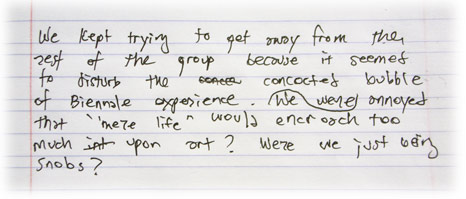 Why am I writing this again?
Why am I writing this again?![]() Oh yes, Biennale experience. Mere life.
Oh yes, Biennale experience. Mere life.![]() Is it a coincidence that this question of mere life is actually one of the primary themes of this year’s Documenta exhibition? Perhaps we should look outside of the context of a self-inflated art exhibition towards another, slightly-less-self-inflated-but-on-the-Grand-Tour-nonetheless art exhibition to get back to this question of mere life.
Is it a coincidence that this question of mere life is actually one of the primary themes of this year’s Documenta exhibition? Perhaps we should look outside of the context of a self-inflated art exhibition towards another, slightly-less-self-inflated-but-on-the-Grand-Tour-nonetheless art exhibition to get back to this question of mere life.![]() Or, perhaps mere life is merely in the looking.
Or, perhaps mere life is merely in the looking.![]() I’ll let you know after we get to Kassel.
I’ll let you know after we get to Kassel.
street-farmer
Big question mark had been floating above my head. There are the situation which I can’t define the meaning, unreadable. I’ve been learning about the world since thirty years, I thought I know most of things I see on the street, at lease in my country… I’ve been passing by that place on the way to go working and to home. At that place, at the side of street, there are a planter with 4 wheels at the bottom, the plant in the planter looks like vegetable and has a tag with the date. The planter is changed every day to other one (vegetable inside become smaller or bigger) and has different date on the tag. One day I notice, at the other side of the street, there are about 10 planters on a line and covered with frames with net.The date on each tag shows there are 5 day different, like 04/15, 04/20, 04/25… there are some empty planter with the coming date. In front of those planter the soil in square trays are prepared. I’ve been wondering what kind of study he is doing?? Are there more planters somewhere? Where is the planter of last year? I went to him very straight when I saw him on the way to home yesterday. He was working with soil in the tray. I really had to ask him what he is doing. Otherwise, i had to be suffered by my big question mark hanging on my head. So, his story was like this; he is raising the vegetable to eat. It takes about five days to eat the vegetable in a planter, so he doesn’t need to waste and ran out, either. He does this work, otherwise he doesn’t have anything to do. He watched on TV that he could raise the vegetable in the planter, and he had been doing this already since four years. He goes zoo every Saturday to get the elephant’s shit for vegetables. (The zoo is distributing the bag of muck to the people every Saturday, at 2 o’clock.) The frame with net can protect bugs. He is just disinfect the soil by sunlight. He fix the wheels because he can move the planter to other side of street easily to get more sunlight for vegetable. He raises Mizuna (potherb mustard) and Komatsuna (Japanese Mustard Spinach) alternately. It takes a months to be ready to eat in summer time and two months in winter time. He gave some Mizuna to me. I told him I’ve been watching his vegetable and eager to know the person who was doing this and reason. I cooked salad of Mizuna and ate. The most fresh Mizuna I ever ate…
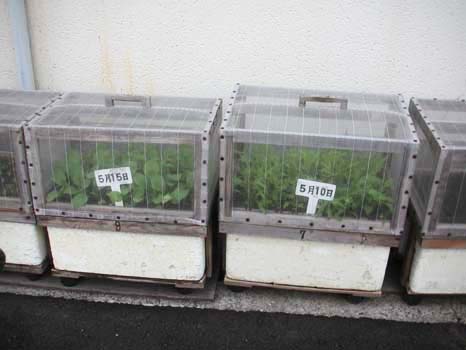
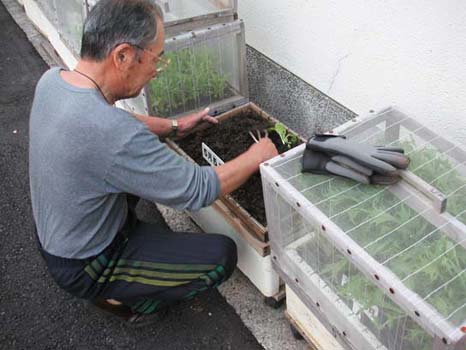
中日文化体育交流年 | china-japan year of culture and sport exchange | 日中文化・スポーツ交流年
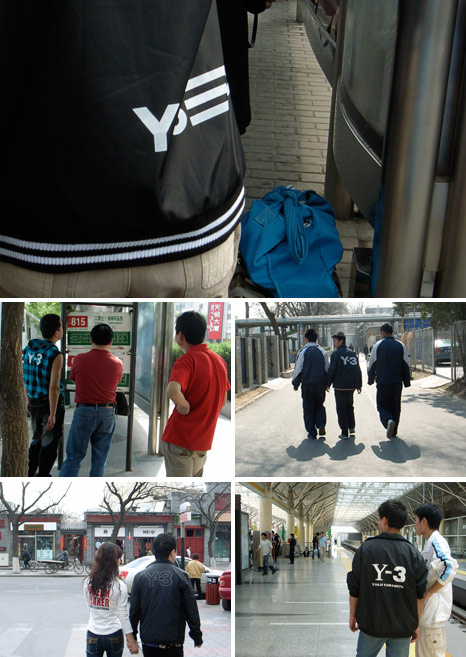
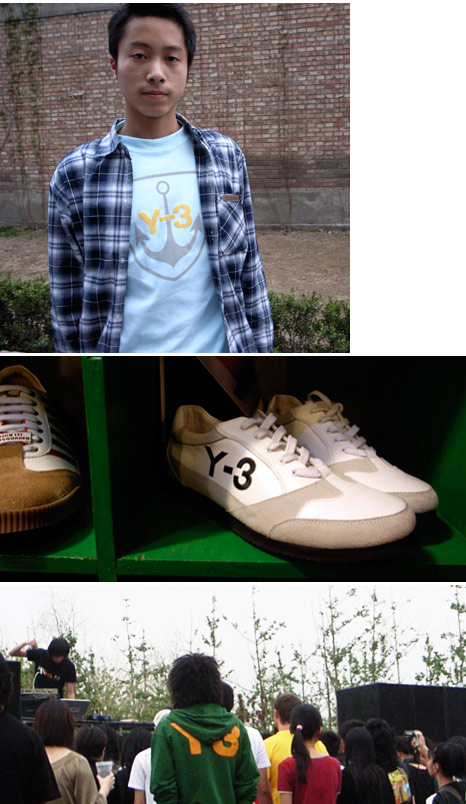
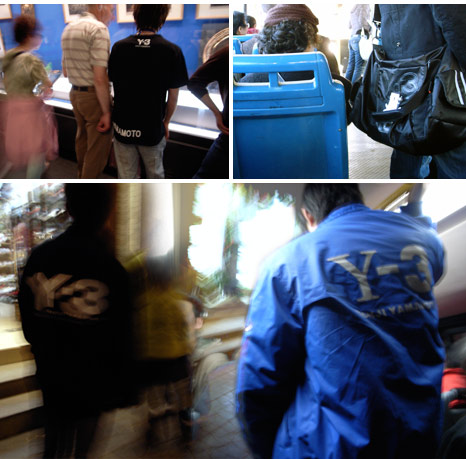
长城 | a great wall | 長城
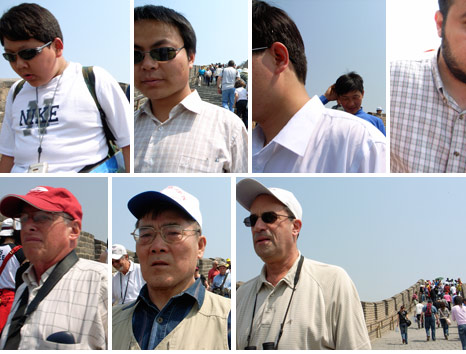
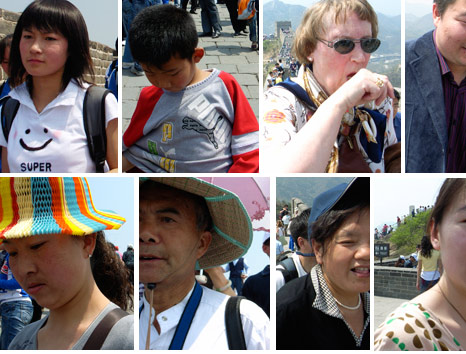
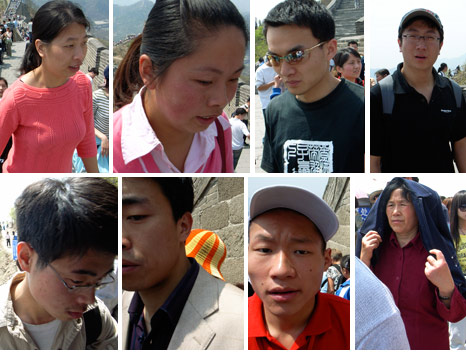
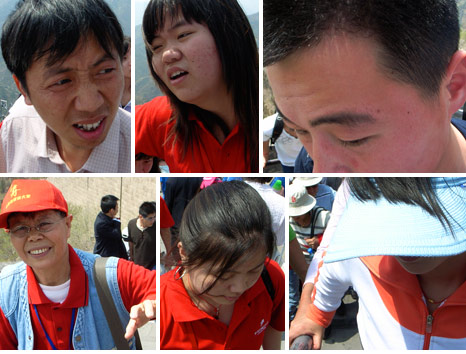
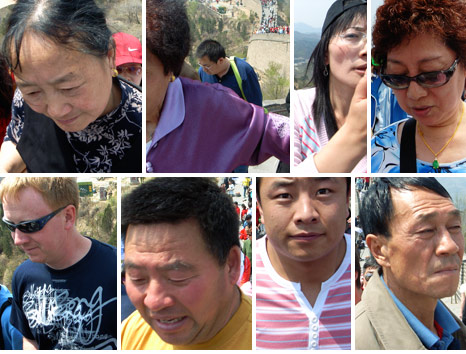
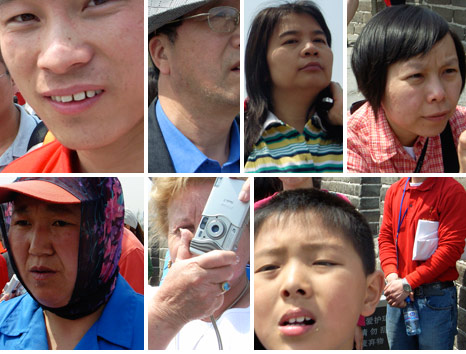
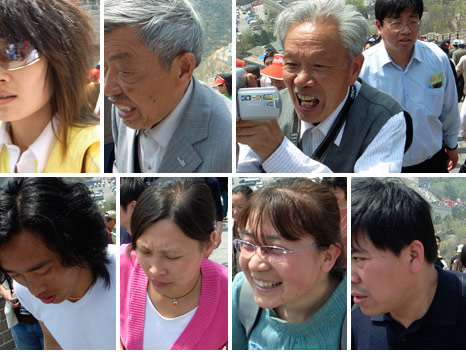
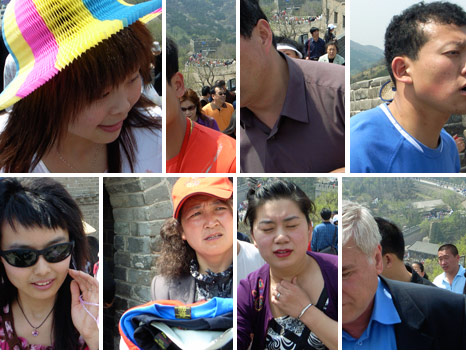
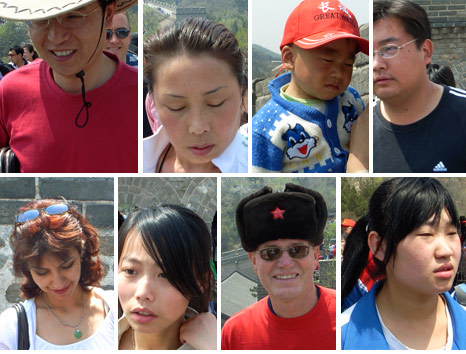
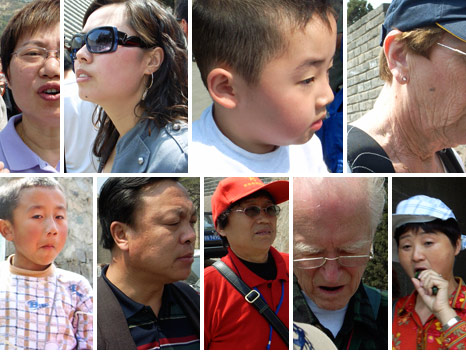
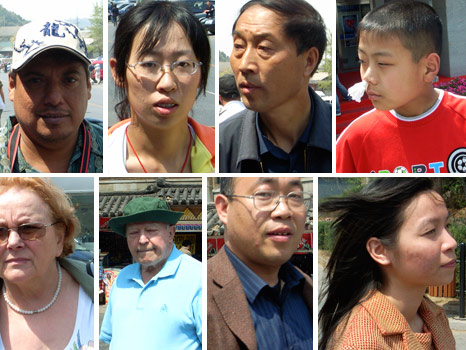
退屈でしにそう, a collected series on boring in nine parts, 无聊死了
c, beijing>>![]()
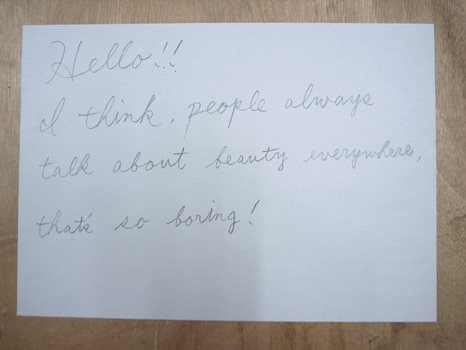
![]()
haxi, beijing>>
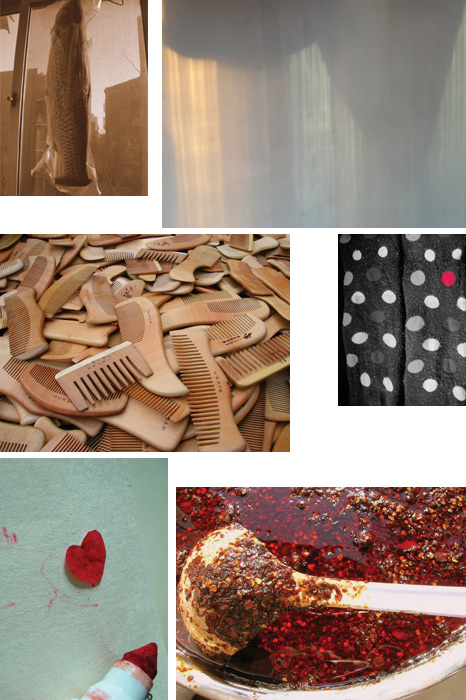
![]()
anyway, osaka>>![]() i’ve tried thinking obout “boring”… it’s hard.this is CONBINI, but without any sign. they were middle of renovation or breaking down. it was on may way to work and wasn’t noticeable when it was still open… it was just one of CONBINI where i didn’t have so much to do with… it had very specific sign like other photos. but one day it lost its face and suddenly started appealing to me with its boringness. how boring building it is… it’s weird that to be very boring can be very visible.
i’ve tried thinking obout “boring”… it’s hard.this is CONBINI, but without any sign. they were middle of renovation or breaking down. it was on may way to work and wasn’t noticeable when it was still open… it was just one of CONBINI where i didn’t have so much to do with… it had very specific sign like other photos. but one day it lost its face and suddenly started appealing to me with its boringness. how boring building it is… it’s weird that to be very boring can be very visible.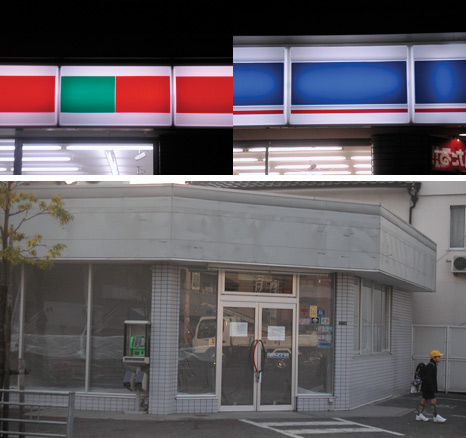
![]()
f, berlin>>
丫, beijing>>
a, beijing>>
haxi and 丫, beijing>>
haxi and a, beijing>>
t, sendai>>
not-yet-expired activity
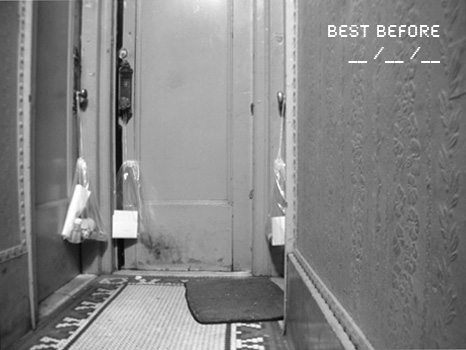 [readings for Best Before; this is what we’re up to; arnhem, boston and beijing in new york, August-October 2006]
[readings for Best Before; this is what we’re up to; arnhem, boston and beijing in new york, August-October 2006]
“The separation between a thing and its environment cannot be absolutely definite and clear-cut; there is a passage by insensible gradations from the one to the other; the close solidarity which binds all the objects of the material universe, the perpetuality of their reciprocal actions and reactions, is sufficient to prove that they have not the precise limits which we attribute to them. Our perception outlines, so to speak, the form of their nucleus; it terminates them at the point where our possible action upon them ceases, where, consequently, they cease to interest our needs. Such is the primary and the most apparent operation of the perceiving mind: it marks out divisions in the continuity of the extended, simply following the suggestions of our requirements and the needs of practical life.” —from Matter and Memory, Bergson
“We ought to think of the historical world according to this model. Why ask if history is made by men or by things, since it is obvious that human initiatives do not annul the weight of things, and the ‘force of things’ always acts through men? It is just this failure of analysis, when it tries to bring everything down to one level, which reveals history’s true milieu. There is no ‘last analysis,’ because there is a flesh of history in which (as in our own body) everything counts and has a bearing — the infrastructure, our idea of it, and above all the perpetual exchanges between the two in which the weight of things becomes a sign as well, thoughts become forces, and the balance of the two becomes events. It is asked, ‘Where is history made? Who makes it? What is this movement which traces out and leaves behind the figures of the wake?’ It is of the same order as the movement of Thought and Speech, and, in short, of the perceptible world’s explosion within us. Everywhere there are meanings, dimensions, and forms in excess of what each ’consciousness‘ could have produced, and yet it is men who speak and think and see. We are in the field of history as we are in the field of language or existence.”These transformations of private into public, of events into meditations, of thought into spoken words and spoken words into thought, this echo coming from everywhere makes it such that in speaking to others we also speak to ourselves, and speak of what exists. This swarming of words behind words, thoughts behind thoughts–this universal substitution is also a kind of stability.” —from Signs, Merleau-Ponty
“Take, for example, a small drawer, which the carpenter has made for the convenience of some housefold. With the passage of time, the actual form of this drawer is surpassed by time itself and, after the decades and centuries have elapsed, it is as though time had become solidified and had assumed that form. A given small space, which was at first occupied by the object, is now occupied by solidified time. It has, in fact, become the incarnation of a certain form of spirit. —from Kinkakuji, Mishima
Posted by secretary | reply »online habit: bookmarks
two kinds of people in terms of using the function of “bookmark this page.” type one: claiming he remembers all daily-read domains (e.g. yahoo.com, gmail.com, flickr.com, friendster.com) so these pages aren’t in bookmarks. rather, “bookmark this page” is used literally. when he is doing some research, and when he comes across some interesting research, he bookmarks it for later review. the links in his bookmarks aren’t checked daily, and may never be checked again. type two: claiming being organized helps better surf the web. she only bookmarks pages that she assumes she will check back tomorrow. she uses “manage bookmarks” every week, deleting, renaming. yahoo.com comes the first in her “mail” folder under the “bookmarks” folder; gmail.com is the second. flickr.com is the first in “tech nerd.” she feels online surfing has been restricted, because other than the bookmarked pages, she doesn’t know anything else.
* * *
— outlook
— tech nerd
— forums
— reading
— languages
—— english
———— writing
—— tibetan
—— chinese
—— nihongo
—— others
— music
— movies
— projectsnow
— temp
